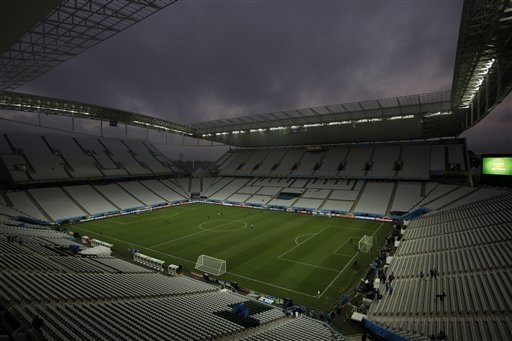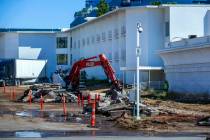Troubled Sao Paulo stadium faces worrisome test
SAO PAULO — The biggest question for today’s opening match of the World Cup isn’t whether host Brazil can beat Croatia but how the unfinished and troublesome Itaquerao stadium will hold up in its first ever encounter with a full-capacity crowd.
Will everything work? More importantly, will the 61,600 spectators be safe? Not even World Cup organizers can be totally sure. Because of chronic delays, worker deaths and other problems during its construction, the new arena has never been match-tested at close to full capacity.
Heads of state, VIPs and other lucky ticket holders will, like it or not, become guinea pigs by making up the first crowd to completely fill the stadium and put full strain on all its facilities, safety plans and equipment, managers and staff.
“If that was me who had to run that event, I’d be extremely nervous,” said John Beattie, president of the European Stadium and Safety Management Association, an industry group of sports-venue executives.
Alarmingly, seemingly lax security at and around the Itaquerao allowed an Associated Press reporter to wander freely this week through unfinished and empty rooms, electrical rooms and uncompleted executive suites. Exposed wires and unfitted lights hung from ceilings. Corridors and other areas smelling strongly of plaster, paint and glue were clogged with uninstalled furniture and fittings, piled up crates of catering equipment and construction materials waiting to be carted away.
Not once in more than two hours Tuesday — some 48 hours before the stadium fills for the opening match — did anyone ask or challenge the reporter as he explored multiple floors, in areas on all four sides of the stadium and in unfinished hospitality tents outside where sponsors and organizers will host guests and clients. Only once, at the perimeter fence when entering the stadium complex, were the reporter’s credentials and heavy bag scanned.
“That’s outrageous,” said Lou Elliston, an inspector at the Sports Grounds Safety Authority, a British government regulator of football venues in England and Wales. She oversaw the openings of the renovated Wembley Stadium in London and the new Emirates Stadium that Arsenal moved to in 2006.
“It’s just unthinkable. You could not wander around Wembley. You would just come across doors that you couldn’t get through. That is a big issue.”
“It’s a security risk, if nothing else,” she added. “The stadium has got to be locked down and secure.”
Beattie added: “For an event of that nature you’d think it would be shut down, you know, a month ago.”
Corinthians, the club that will use it after the World Cup, said the venue received all the necessary permits from local authorities for the opening game. FIFA didn’t immediately respond to emailed questions. Brazilian World Cup organizers said inspections “for the safety and security licenses have been completed in line with standard Brazilian procedures.”
“All will be in place for the opening match,” the organizing committee said in a one-paragraph statement.
Inside the arena, one corridor behind an open door marked “Medical Room” in fact led to a completely empty room. Electrical wires poked out from walls and ceilings. Safety barriers to prevent people from tumbling onto seated spectators waited under plastic to be fitted.
In temporary tented areas just outside the stadium where sponsors will welcome guests, sink units in washrooms were strewn on the floor or leaned against each other, awaiting plumbers. One main stadium entrance was cluttered with piles of unfitted furniture and other fittings under plastic wraps.
By the end of the day, outside lighting that was lying on the ground just hours earlier was installed and working.
“That doesn’t sound like tidying up work to me. That sounds like ‘you’re still struggling to get the place open’ work,” Beattie said.




























